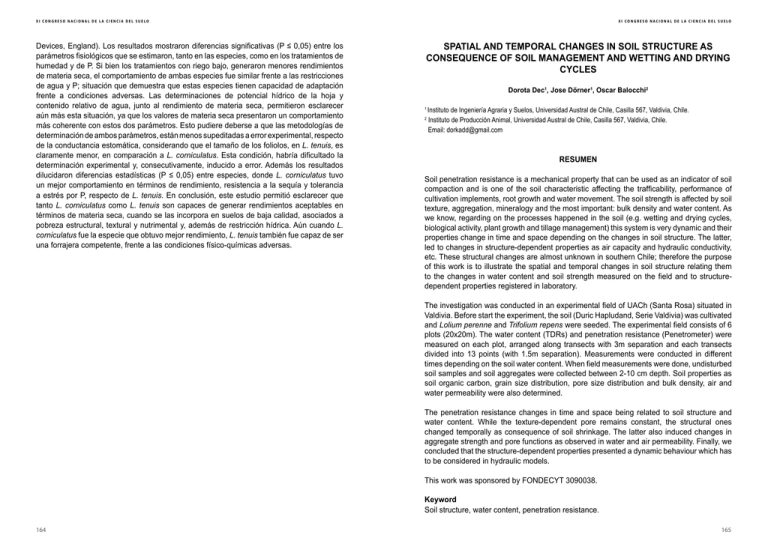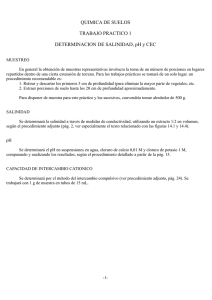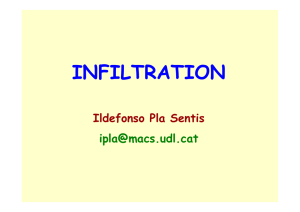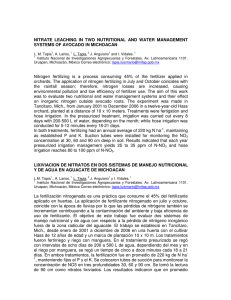spatial and temporal changes in soil structure as consequence of
Anuncio

XI CONGRESO NACIONAL DE LA CIENCIA DEL SUELO XI CONGRESO NACIONAL DE LA CIENCIA DEL SUELO Devices, England). Los resultados mostraron diferencias significativas (P ≤ 0,05) entre los parámetros fisiológicos que se estimaron, tanto en las especies, como en los tratamientos de humedad y de P. Si bien los tratamientos con riego bajo, generaron menores rendimientos de materia seca, el comportamiento de ambas especies fue similar frente a las restricciones de agua y P; situación que demuestra que estas especies tienen capacidad de adaptación frente a condiciones adversas. Las determinaciones de potencial hídrico de la hoja y contenido relativo de agua, junto al rendimiento de materia seca, permitieron esclarecer aún más esta situación, ya que los valores de materia seca presentaron un comportamiento más coherente con estos dos parámetros. Esto pudiere deberse a que las metodologías de determinación de ambos parámetros, están menos supeditadas a error experimental, respecto de la conductancia estomática, considerando que el tamaño de los foliolos, en L. tenuis, es claramente menor, en comparación a L. corniculatus. Esta condición, habría dificultado la determinación experimental y, consecutivamente, inducido a error. Además los resultados dilucidaron diferencias estadísticas (P ≤ 0,05) entre especies, donde L. corniculatus tuvo un mejor comportamiento en términos de rendimiento, resistencia a la sequía y tolerancia a estrés por P, respecto de L. tenuis. En conclusión, este estudio permitió esclarecer que tanto L. corniculatus como L. tenuis son capaces de generar rendimientos aceptables en términos de materia seca, cuando se las incorpora en suelos de baja calidad, asociados a pobreza estructural, textural y nutrimental y, además de restricción hídrica. Aún cuando L. corniculatus fue la especie que obtuvo mejor rendimiento, L. tenuis también fue capaz de ser una forrajera competente, frente a las condiciones físico-químicas adversas. SPATIAL AND TEMPORAL CHANGES IN SOIL STRUCTURE AS CONSEQUENCE OF SOIL MANAGEMENT AND WETTING AND DRYING CYCLES Dorota Dec1, Jose Dörner1, Oscar Balocchi2 Instituto de Ingeniería Agraria y Suelos, Universidad Austral de Chile, Casilla 567, Valdivia, Chile. Instituto de Producción Animal, Universidad Austral de Chile, Casilla 567, Valdivia, Chile. Email: [email protected] 1 2 Resumen Soil penetration resistance is a mechanical property that can be used as an indicator of soil compaction and is one of the soil characteristic affecting the trafficability, performance of cultivation implements, root growth and water movement. The soil strength is affected by soil texture, aggregation, mineralogy and the most important: bulk density and water content. As we know, regarding on the processes happened in the soil (e.g. wetting and drying cycles, biological activity, plant growth and tillage management) this system is very dynamic and their properties change in time and space depending on the changes in soil structure. The latter, led to changes in structure-dependent properties as air capacity and hydraulic conductivity, etc. These structural changes are almost unknown in southern Chile; therefore the purpose of this work is to illustrate the spatial and temporal changes in soil structure relating them to the changes in water content and soil strength measured on the field and to structuredependent properties registered in laboratory. The investigation was conducted in an experimental field of UACh (Santa Rosa) situated in Valdivia. Before start the experiment, the soil (Duric Hapludand, Serie Valdivia) was cultivated and Lolium perenne and Trifolium repens were seeded. The experimental field consists of 6 plots (20x20m). The water content (TDRs) and penetration resistance (Penetrometer) were measured on each plot, arranged along transects with 3m separation and each transects divided into 13 points (with 1.5m separation). Measurements were conducted in different times depending on the soil water content. When field measurements were done, undisturbed soil samples and soil aggregates were collected between 2-10 cm depth. Soil properties as soil organic carbon, grain size distribution, pore size distribution and bulk density, air and water permeability were also determined. The penetration resistance changes in time and space being related to soil structure and water content. While the texture-dependent pore remains constant, the structural ones changed temporally as consequence of soil shrinkage. The latter also induced changes in aggregate strength and pore functions as observed in water and air permeability. Finally, we concluded that the structure-dependent properties presented a dynamic behaviour which has to be considered in hydraulic models. This work was sponsored by FONDECYT 3090038. Keyword Soil structure, water content, penetration resistance. 164 165


